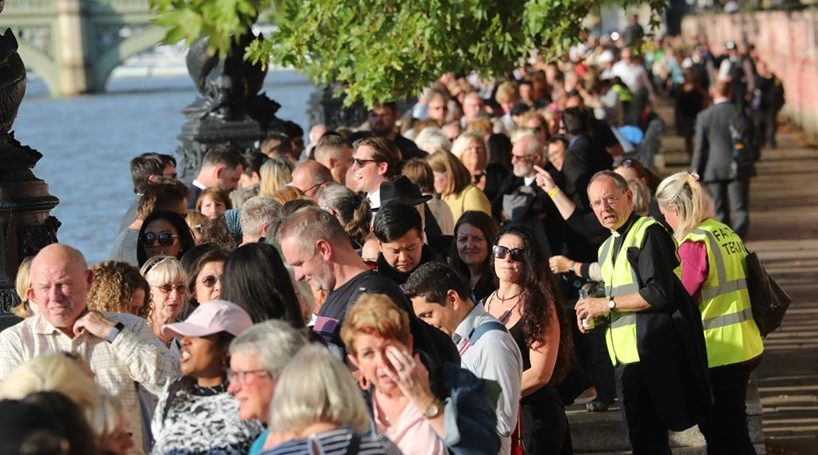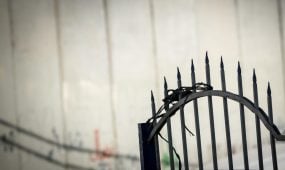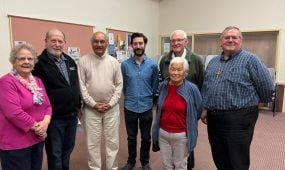A long line of faith: Chaplains minister to the thousands waiting to say a final farewell
News
Dressed in black clerical shirts and fluorescent tabards emblazoned “Faith Team”, Archbishops Welby and Cottrell were among the Anglican priests to join faith leaders from other denominations and religions in a chaplaincy team serving the queue of people waiting to see the Queen lying in state

They came to the queue in their dog-collars – both those waiting in line, and those ministering to the people waiting to see the Queen lying in state.
On Thursday morning, the Archbishops of Canterbury and York joined the 300-strong multifaith chaplaincy team that had been put together in the days following the Queen’s death.
Dressed in black clerical shirts and fluorescent tabards emblazoned “Faith Team”, Archbishops Welby and Cottrell were among the Anglican priests to join faith leaders from other denominations and religions in a chaplaincy team serving the queue.
In recent days, the queue has seemed to take on a personality of its own – being described as a “river of humanity”. When I first wandered along it on Thursday afternoon, it snaked down to Blackfriars Bridge; by Friday morning, it had filled Southwark Park, and officials announced that entry to the queue would be paused for at least six hours.
The chaplaincy team was set up by Lambeth Palace in collaboration with the Department for Digital, Culture, Media and Sport (DCMS). The head of chaplaincy at Guy’s and St Thomas’ NHS Trust, Mia Kyte Hilborn, who is leading the team, described it as a “privilege” to be involved.
The chaplains’ duty was to be present not only for those in the queue, but also for those marshalling and policing the event, she said on Thursday. Archbishop Cottrell, who had been out and about with a Sikh chaplain that morning, had been particularly delighted to discover that some of the police on duty were from South Yorkshire, Ms Kyte Hilborn said.
“People beam when they see a chaplain,” she told me – a description that was born out in the testimony of some of the chaplains I met later in the evening, while they enjoyed a cup of tea and a biscuit at the end of their shift.
Advertisement
St Matthew’s, Westminster, on Great Peter Street, is one of several “hubs” that has been set up for the chaplaincy team. When I visited, it was being manned by the pastoral assistant at St Matthew’s, Daniel Binder, and 13-month old Bunter, the vicar’s spaniel (though not of the breed which shares a name with the new monarch).
Soon, the chaplains arrived, legs aching after their shift but full of enthusiasm.
“There is a special ministry in hanging around, and just being present with people,” said the Revd Dr Charlie Bell, a self-supporting minister at St John the Divine, Kennington.
“The Church of England is, to some extent, still chaplain to the nation,” he said.
He observed that, in this period of national mourning, there seemed to be an instinctive turn towards the Church, and its clerics.
“Wearing a collar on public transport, people have spoken to me more often than before. It was amazing how many people said ‘thank you for being here.’”
Those in the queue greeted the chaplains with open arms, sometimes quite literally: the Revd Joyce Forbes, an assistant priest at St Stephen’s, Norbury and Thornton Heath, in Southwark diocese, described meeting a woman in the queue who gave her a hug as soon as she saw that she was a chaplain.
Advertisement
“I felt quite honoured to offer myself for this role – I felt it was something practical I could do,” Ms Forbes said, in what was a common refrain among the chaplains.
Like most, the Revd Obi Chike, chaplain of University College London Hospital, had not yet been able to go into Westminster Hall to see the Queen’s coffin lying in state; but she felt able to honour the Queen “by supporting those who were coming to see her”.
Unlike journalists (and MPs and their guests, according to a BBC report on Thursday), chaplains do not get to skip the queue (unless they also happen to be members of the House of Lords). One who had just finished his shift had a quick cup of tea before heading off back down the river to join the end of the queue. Dr Bell intended to do the same, having been inspired by the conversations he had had during his shift.
They would not be the only people wearing dog collars in the queue. There were, the chaplains observed, a fair number on show.
“I even bumped into my vicar!” Ms Forbes exclaimed, and it turned out I had met him, too, several hours earlier.
First published on Church Times on 16 September 2022. Visit the Church Times website to subscribe today.





